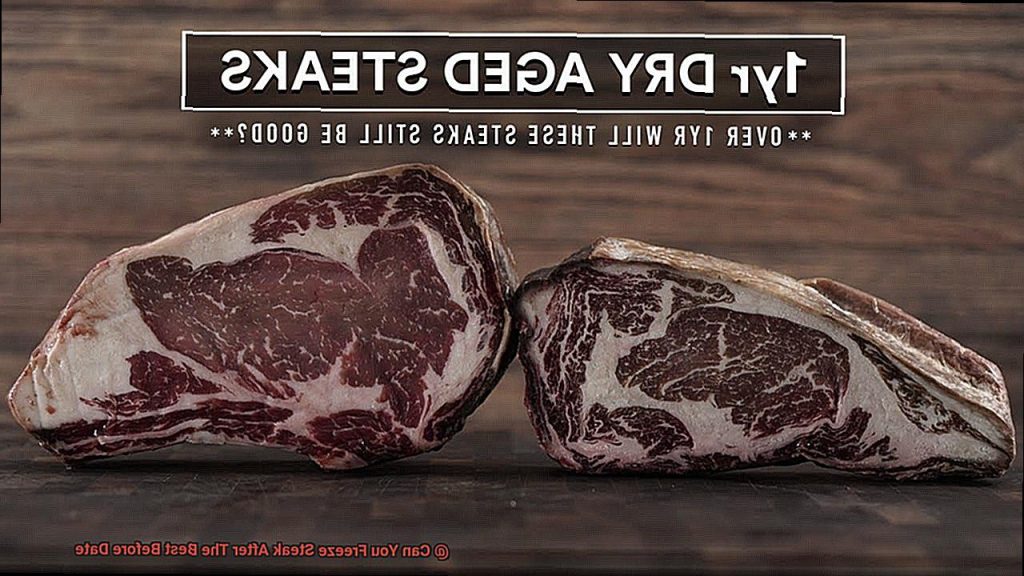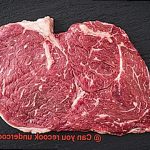Do you find yourself scouring the clearance section of your local grocery store for a good deal on steak, only to realize that the best before date has already passed?
Or maybe life got in the way and you forgot about that steak sitting in your fridge for an extra day or two. Don’t worry, freezing that steak could be your saving grace.
But can you really freeze steak after the best before date has expired? The answer is yes, but there are a few important things to keep in mind.
In this blog post, we’ll dive into the safety and practicality of freezing steak past its best before date. We’ll cover proper storage techniques and thawing methods, as well as discuss potential risks and benefits of freezing meat beyond its expiry date.
Plus, we’ll touch on how freezing can affect the texture and flavor of your beloved steak. Whether you’re trying to salvage forgotten meat or looking to stock up on discounted cuts, this post has got you covered.
So, let’s find out.
Contents
What is the Best Before Date?
The Best Before Date is a label that suggests the estimated period until which a food product retains its quality and freshness.
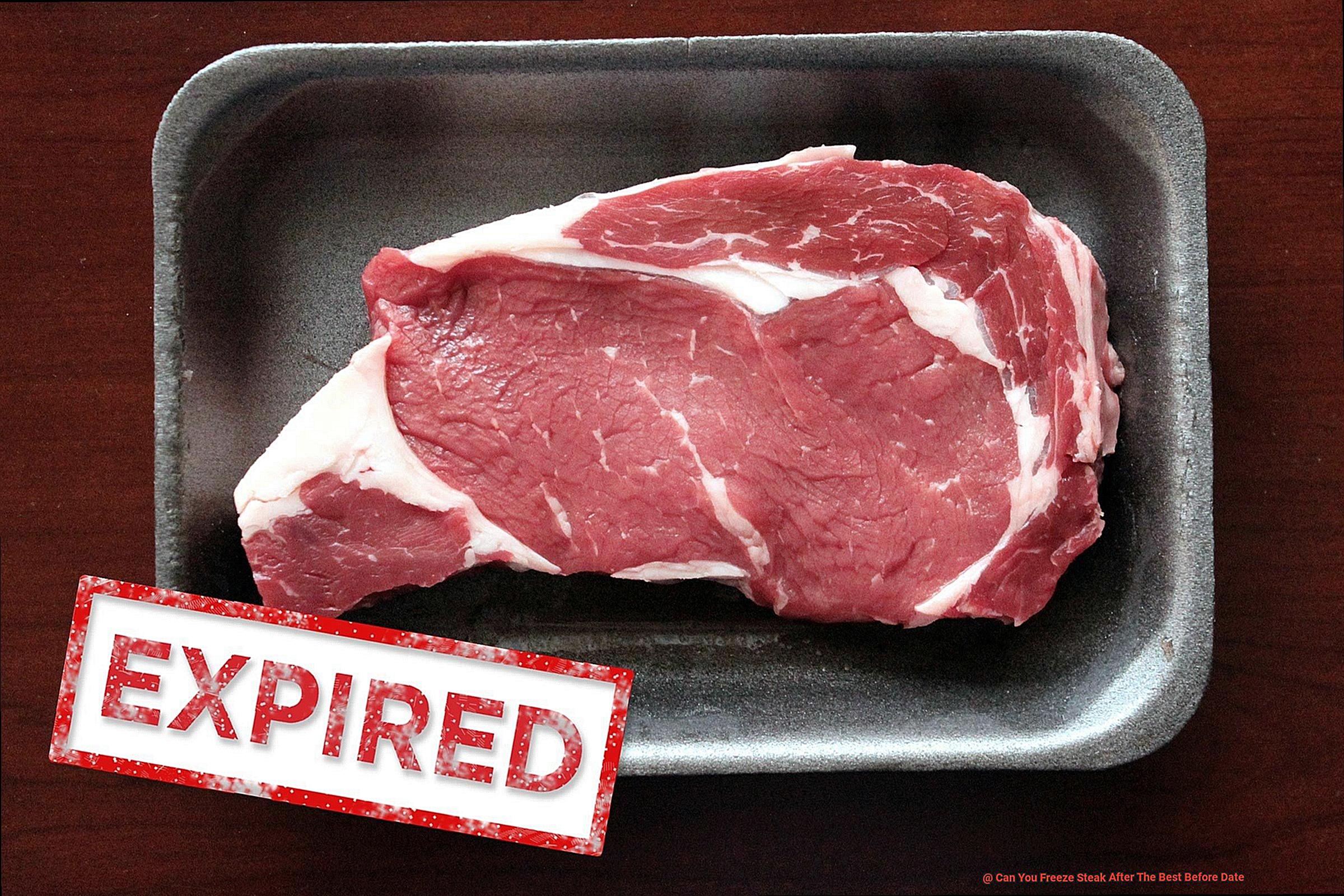
It’s not an expiry date, but rather a recommendation on when to consume the food item for optimal quality. You’ll typically find the Best Before Date on perishable items such as meat, dairy products, and baked goods.
The date is determined based on factors like the type of food, storage conditions, and packaging. For example, if you store a food item in a cool, dry place, it may last beyond the Best Before Date indicated on the label.
On the other hand, exposing a food item to heat and humidity may cause it to spoil before the suggested date. Proper storage and handling of food items can help extend their shelf life beyond the Best Before Date.
However, once you open a package, its shelf life may be shorter than the Best Before Date indicated on the label. Therefore, it’s crucial to use your senses to determine if a food item is safe to eat after its Best Before Date has passed.
If you’re wondering whether you can freeze steak after its Best Before Date has passed, the answer is yes. Freezing steak can help extend its shelf life and prevent it from spoiling.
But there are some important things to keep in mind. Firstly, make sure that the steak was stored correctly before the Best Before Date.
If it wasn’t stored at the right temperature or was exposed to contaminants, freezing it won’t make it safe to eat. Secondly, freeze the steak as soon as possible after purchasing or cooking it to preserve its quality and texture.
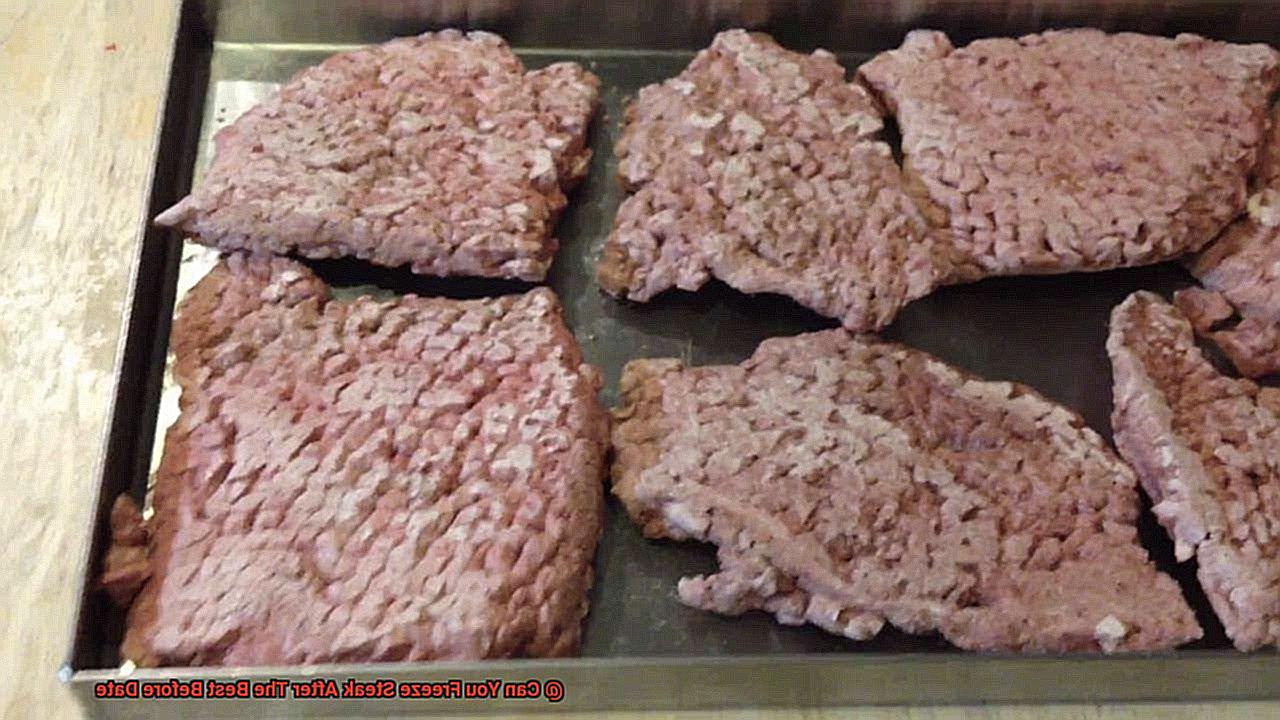
Wrapping it tightly in freezer-safe packaging is also essential to prevent freezer burn caused by exposure to air. In summary, the Best Before Date is a helpful suggestion on when to consume a food item for optimal quality.
And while freezing steak after its Best Before Date has passed is possible, it’s critical to ensure that it was stored correctly before freezing it.
Can You Freeze Steak After The Best Before Date?
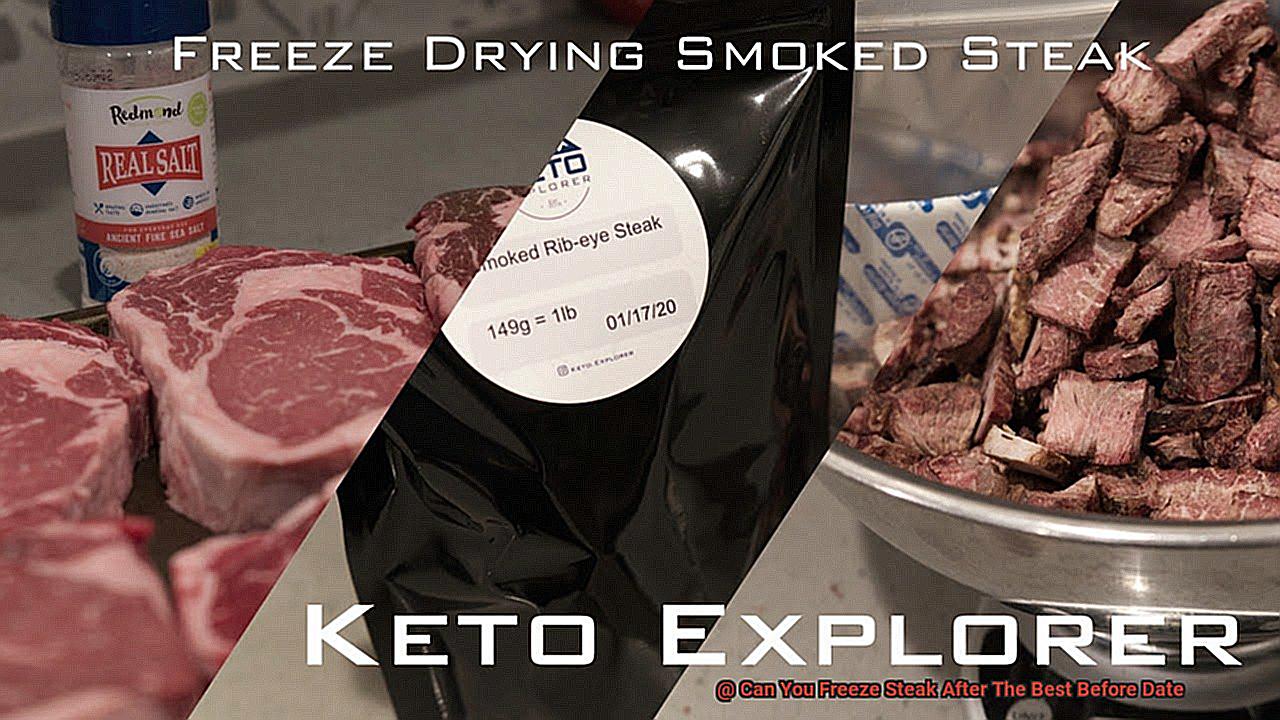
First, let’s clear up a common misconception – the best before date is not an expiry date.
It’s merely a suggestion from the manufacturer for when the product is at its optimal quality and freshness. So, if your steak has been stored properly in the fridge at 40°F or below, you can still freeze it even after the best before date has passed.
However, it’s essential to ensure that your steak was stored correctly before freezing. If it was left at room temperature for an extended period, it may have developed harmful bacteria and should not be frozen.
But if you’ve confirmed that it was stored correctly, then you’re good to go. It’s important to note that freezing doesn’t kill bacteria; it merely prevents them from multiplying.
Therefore, if your steak was contaminated before freezing, it can still pose a risk to your health. So, always exercise caution when handling meat.
When freezing steak, make sure to wrap it tightly in plastic wrap or aluminum foil to prevent freezer burn. Freezer burn can affect the texture and taste of your steak by causing dehydration and oxidation.
Alternatively, you can use a vacuum sealer to ensure that no air gets in contact with your steak. Don’t forget to label your package with the date of freezing and try to use it within 6-12 months for optimal quality.
While frozen steak after the best before date is safe as long as it was stored correctly and frozen immediately, bear in mind that the quality may not be as good as fresh steak. It could be tougher or lose some of its flavor over time.
Storing Steak Properly Before the Best Before Date
Although the best before date indicates when the quality of the steak may start to deteriorate, it does not necessarily mean that it’s no longer safe to eat. Follow these simple steps to store your steak properly before the best before date.
- Firstly, keep the steak in its original packaging. The packaging should either be vacuum-sealed or wrapped tightly in plastic to prevent air from entering. This is critical in preventing freezer burn and preserving the quality of the meat. The packaging acts as a protective shield for your precious steak.
- Secondly, maintaining a consistent temperature of 0°F (-18°C) or below is crucial. Any fluctuations in temperature can cause ice crystals to form on the meat, which can result in freezer burn and adversely affect the taste and texture of the steak. To prevent this, make sure your freezer’s temperature is set correctly to keep your steak fresh.
- Lastly, label and date the packaging when storing steak in the freezer. By doing this, you can monitor when it was stored and consume it before it expires or becomes unsafe to eat. This will help you avoid any food wastage and ensure that your steak remains safe and fresh.
Remember, proper storage involves keeping your steak in its original packaging, maintaining a consistent temperature of 0°F or below, and labeling and dating the packaging for future use.
Freezing Steak After the Best Before Date
You can still enjoy your succulent steak by freezing it for later consumption. As an expert in freezing steak after the best before date, let me share some valuable considerations to keep in mind.
First, it’s crucial to understand that the best before date is not synonymous with the expiration date. The former simply denotes the period during which the product is at its freshest and of optimal quality.
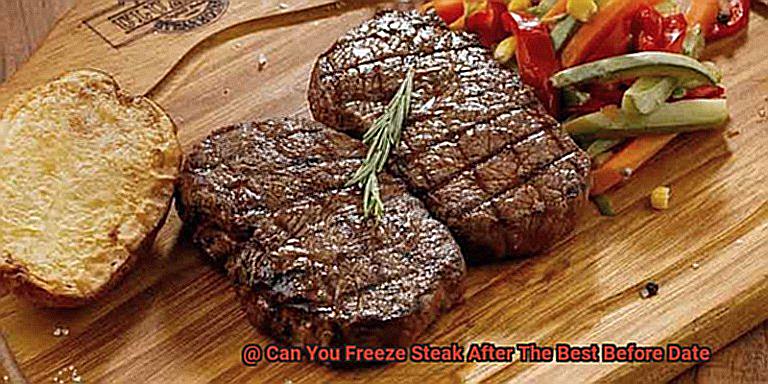
However, if your steak has surpassed its best before date but you still want to freeze it for future use, there are some steps you should follow to ensure its safety and quality. To preserve your steak’s freshness and texture, make sure to wrap or package it securely before placing it in the freezer.
This will prevent freezer burn and other forms of damage that can occur over time. Additionally, label the steak with the date when it was frozen so that you can keep track of how long it has been in the freezer.
Stored correctly, frozen steak can last several months in the freezer without compromising on taste or nutritional value. When it comes time to thaw your steak, avoid taking shortcuts that might jeopardize its safety.
The best way to thaw frozen steak is by placing it in the refrigerator overnight, allowing it to thaw slowly and evenly. Avoid thawing your steak at room temperature or in hot water, as this can lead to bacterial growth and other safety concerns.
Think of proper packaging as armor protecting your precious meat from freezer burn and maintain a consistent temperature of 0°F or below like a vigilant guardian.
Tips for Freezing Steak After the Best Before Date
Freezing steak after the best before date is possible with these helpful tips.
Checking for Freshness
The first step to freezing steak after the best before date is to ensure that it’s still fresh.
Check for any signs of spoilage, such as a strange odor or discoloration on the meat.
If the steak looks or smells off, it’s better to be safe than sorry and discard it.
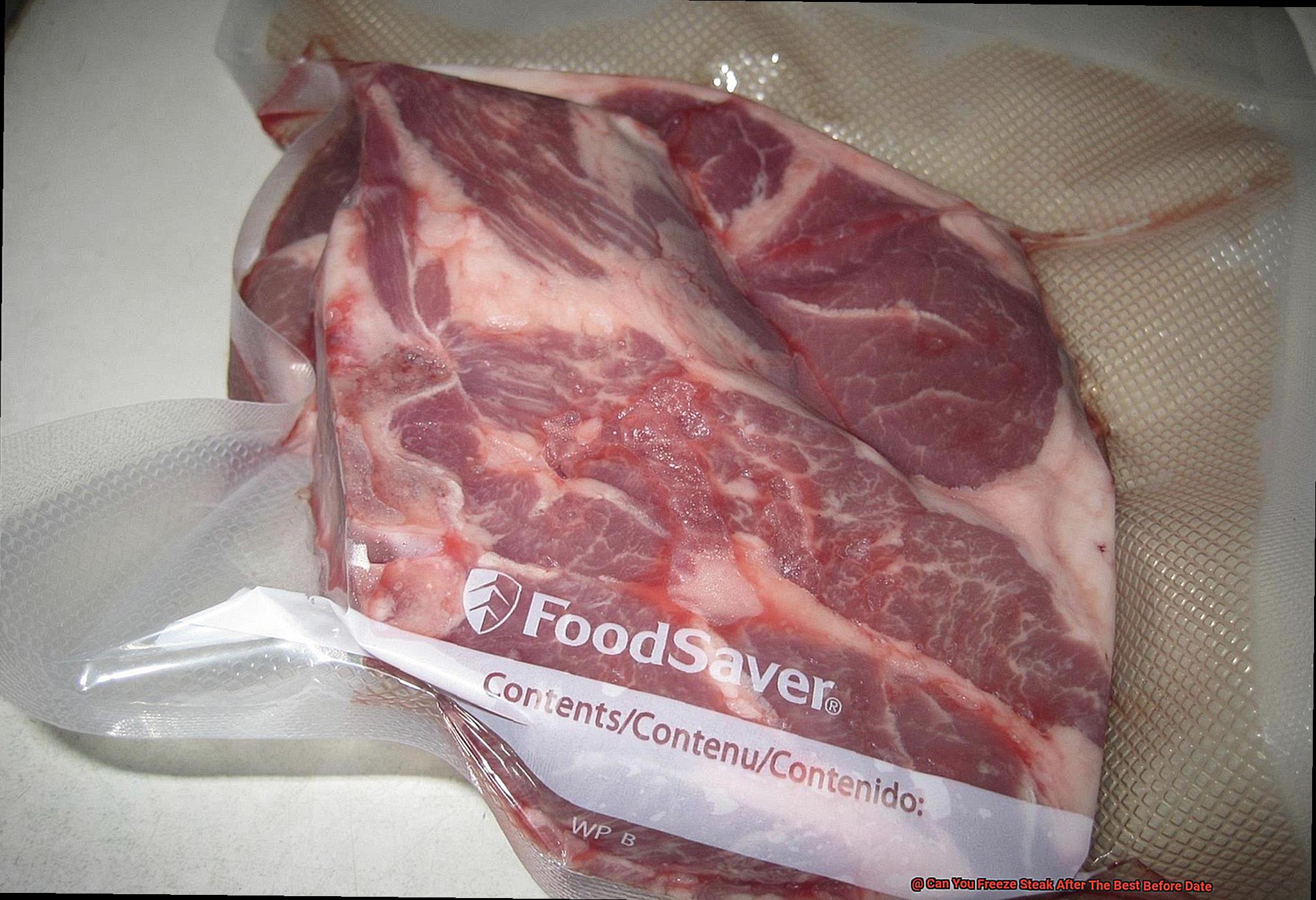
Proper Storage
Once you’ve confirmed that your steak is still fresh, it’s time to freeze it. But before you do, make sure that it was stored properly before the best before date.
This means that it should have been kept in the refrigerator at or below 40°F and not left out at room temperature for more than two hours.
Wrapping it Up
To prevent freezer burn and maintain the flavor of your steak, tightly wrap it in plastic wrap or aluminum foil. You may also want to consider using a vacuum-sealed bag for freezing, which removes all air from the package and preserves the quality of meat for longer periods.
Labeling
Don’t forget to label your frozen steak with the date that you froze it. This will help you keep track of how long it’s been in the freezer and ensure that you don’t end up with spoiled meat.
Generally speaking, steak can be stored safely in the freezer for up to six months, but this will depend on factors such as meat quality and storage conditions.
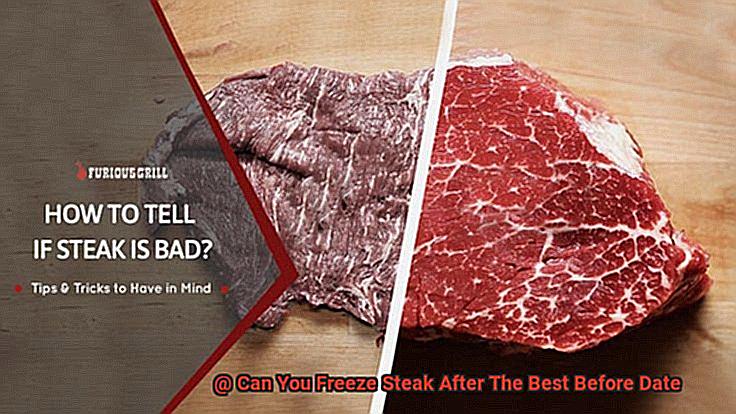
Safe Thawing
The final step before enjoying your frozen steak is thawing it safely. The best method is to place your steak in the refrigerator overnight, allowing it to thaw slowly over 24-48 hours.
Avoid thawing your steak at room temperature or in hot water, as this can increase the risk of bacterial growth and potentially unsafe meat temperatures.
So, freezing steak after the best before date is a great way to avoid waste and still enjoy a delicious meal.
By checking for freshness, storing it properly, wrapping it tightly, labeling it, and thawing it safely, you can confidently enjoy your frozen steak without any worries.
Thawing Frozen Steak Safely
With these tips, you can safely thaw your frozen steak and enjoy a mouthwatering meal.
First, never thaw your steak at room temperature or in warm water. This can lead to bacterial growth and spoilage, making it unsafe to eat.
Instead, opt for the slow and safe method of moving your steak from the freezer to the fridge. Allow it to thaw for 24-48 hours before cooking.
This ensures that the steak thaws evenly and retains its texture and flavor. If time is not on your side and you need to thaw your steak quickly, a cold water bath is your best bet.
Place your frozen steak in a leak-proof bag and submerge it in cold water. Be sure to change the water every 30 minutes until the steak is fully thawed.
Depending on the size and thickness of your steak, this can take anywhere from 30 minutes to 2 hours. Avoid using a microwave to thaw your steak as this can result in uneven thawing and partially cooked spots in the meat.
In addition, be sure to cook your fully thawed steak within 3-5 days for optimal freshness and quality. If you’re unable to cook it within this timeframe, it’s safe to refreeze it.
However, keep in mind that this may affect the texture and flavor of the meat. In conclusion, taking the time to properly thaw frozen steak is essential for ensuring that it’s safe and delicious to eat.
KO2OG1Kb4tw” >
Conclusion
In conclusion, freezing steak after the best before date can save you from wasting food while ensuring safety and practicality.
However, it’s important to ensure that the steak was stored correctly before freezing and is still fresh. Freezing helps prevent bacterial growth but won’t eliminate existing bacteria.
To preserve your meat’s quality and texture, proper storage techniques are crucial. Wrap the steak tightly in plastic wrap or aluminum foil, label it with the date of freezing, and maintain a consistent temperature of 0°F or below.
When thawing frozen steak, avoid shortcuts that may compromise its safety. The best method is to place it in the refrigerator overnight for slow and even thawing.
Remember that proper packaging acts as armor protecting your precious meat from freezer burn while maintaining a consistent temperature like a vigilant guardian.

